 |
| August 13, 2019 | Volume 15 Issue 30 |
Designfax weekly eMagazine
Archives
Partners
Manufacturing Center
Product Spotlight
Modern Applications News
Metalworking Ideas For
Today's Job Shops
Tooling and Production
Strategies for large
metalworking plants
Hole-y moly! Lotus all-electric hypercar features giant Venturi tunnels
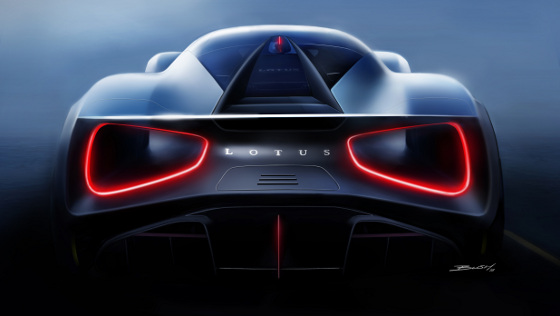
Hypercars can all seem the same after a while, at least for those of us who can't afford them! But the almost 2,000-hp all-electric Lotus Evija (pronounced "E-vi-ya") has some really different design and function details.
For starters, you can't miss those huge Venturi tunnel exits at the back of the vehicle in their giant, red LED taillight frames. It's also the first Lotus road car to feature a one-piece carbon fiber monocoque chassis, and it's a world-first to use both main- and dipped-beam laser lighting. And to top it off, this well may be the new world's most powerful series production road car.
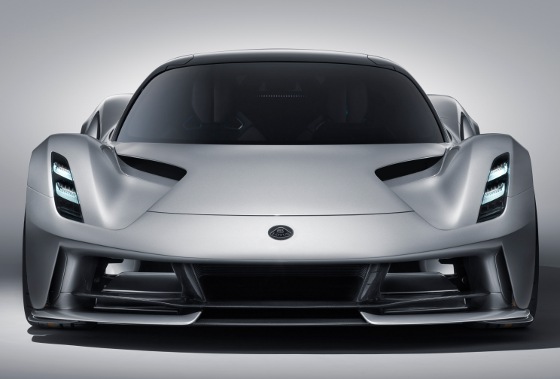
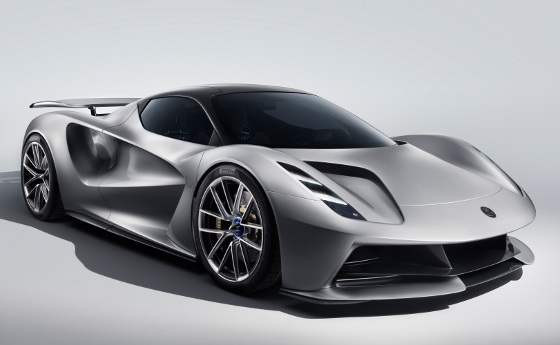
This is the first hypercar from Lotus and the company's first model with an electrified powertrain, so the project presented a perfect clean-sheet opportunity. But there was a lot of historical Lotus inspiration included.
"We studied how Le Mans race cars use air flow creatively to go over, under, and around the vehicle, but also through it," said Russell Carr, design director, Lotus Cars. "This concept of 'porosity' is key to the Evija and has enabled us to create a timeless design with exceptional amounts of downforce."
At the heart of the Evija is an ultra-advanced all-electric powertrain. It has been developed by technical partner Williams Advanced Engineering, famed for success in motorsport, from Formula One to electrifying the first four seasons of Formula E. The battery pack is mid-mounted immediately behind the two seats and supplies energy directly to four powerful e-motors. Lotus says this highly efficient system is "the lightest, most energy dense electric power package ever fitted to a road car." With a target weight of just 1,680 kg, it will be the lightest pure electric hypercar ever to go into series production.
Engineered for precise and sustained performance, the Evija has five driving modes: Range, City, Tour, Sport, and Track. It can race from 0 to 62 mph (0 to 100 km/h) in under 3 sec and accelerate to a top speed of more than 200 mph (0 to 320 km/h).
"Every element of the Evija has been meticulously analyzed and validated," said Matt Windle, executive director, Sports Car Engineering, Lotus Cars. "Precision engineering is nothing without human engagement, and that's why technology with soul is the benchmark for this and every Lotus."
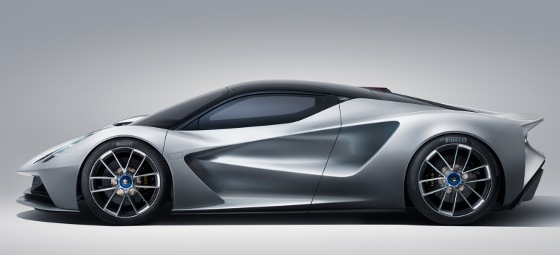
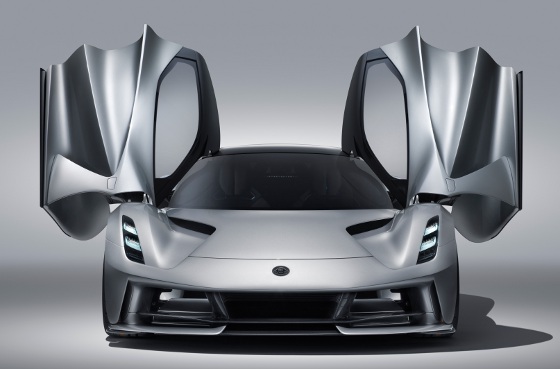
The most striking element of the Lotus Evija is its exterior. From every angle, the full carbon fiber bodywork is stretched taut, appearing "shrink-wrapped" over the mechanical components. Crouching low to the ground, with a ride height of just 105 mm, the muscular haunches envelop the teardrop cabin that sinks between them.
The exterior takes a lot of its inspiration from the aeronautics industry, with fluid forms and crisp lines. But the Evija's surface language was also taken from nature.
"During the initial design stage, we spent many hours studying images of geological forms -- rocks that had been carved by nature over the centuries," said Carr. "We believe we've captured these beautiful, intriguing, and elemental lines within the Evija."
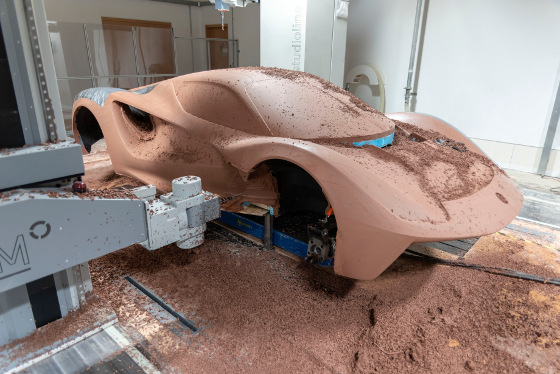
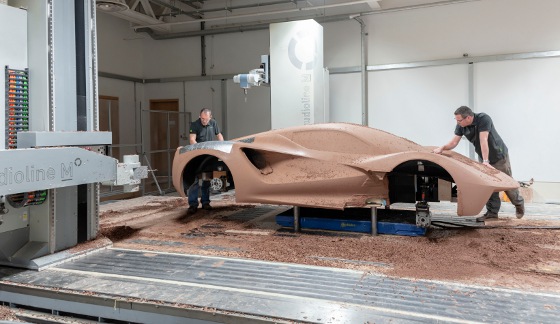
Physical modeling involved both automated machining and lots of hand work.
Inspired by Le Mans race cars, the Venturi tunnels that pierce each rear quarter aim to optimize air flow by directing it through the bodyshell. They aid the delivery of high-energy air flow to the rear of the car. This, in turn, counteracts the low pressure behind the car to reduce drag. Furthermore, the Venturi effect inside the tunnels pulls air through the rear wheel arch louvres, maintaining air quality in the diffuser.
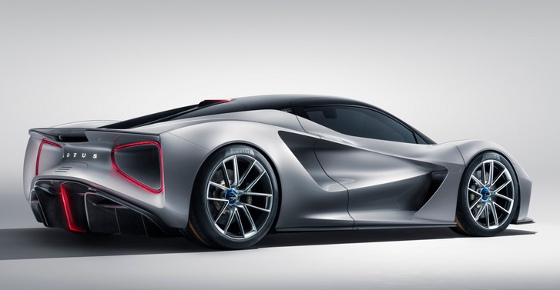
When viewed from the rear of the car, each tunnel is edged with a red LED, creating a striking ribbon-style light signature. The effect mimics the afterburners on a fighter jet, especially when seen at night. As an extra detail, an LED hidden within each tunnel illuminates its interior.
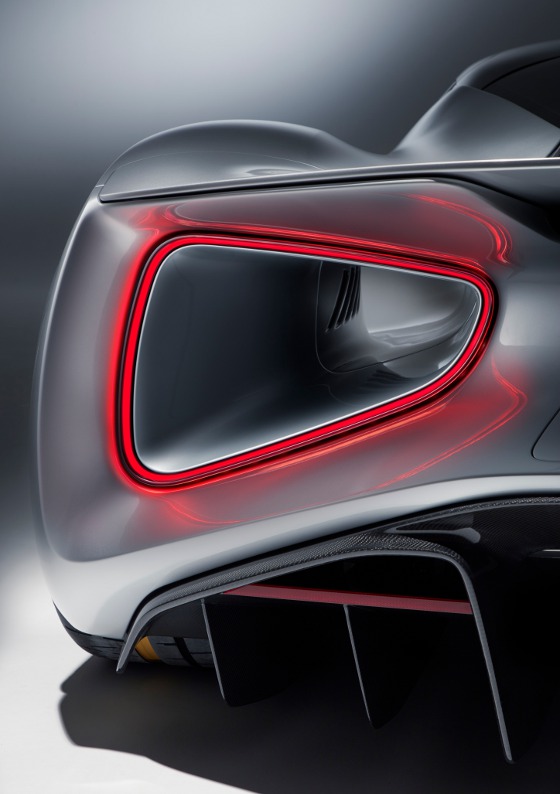
The directional indicators are incorporated into the corners of the ribbon, while the reversing light is provided by the illuminated "T" of the "LOTUS" wordmark above the integrated charging flap.
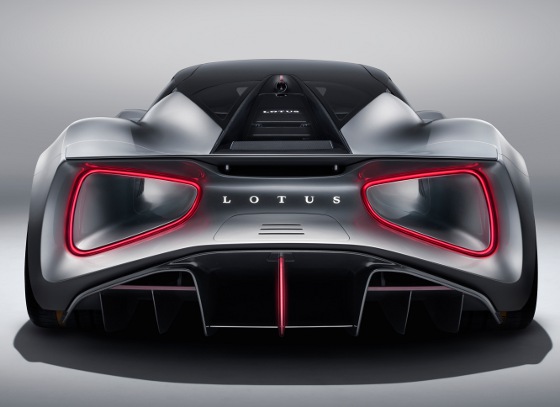
Another key feature of the Evija's sophisticated aerodynamic system is the bi-plane front splitter. Designed in three sections, the larger central area provides air to cool the battery pack, which is mid-mounted behind the two seats, while the air channeled through the two smaller outer sections cools the front e-axle. Lotus says that brand aficionados may notice a respectful nod to the iconic Type 72 Formula 1 car, with its square front central section and two side wings.
The Evija is the first production road car in the world to feature laser lights for both main and dipped beams. Produced by Osram, the strikingly thin vertical headlamp modules are very compact and provide an outstanding view of the road or track ahead. Inside the lenses, unique "wing-like" elements form the daytime running lights and directional indicators.
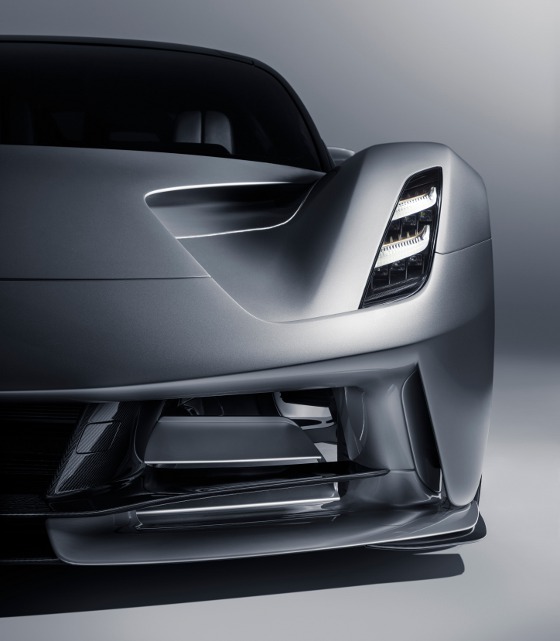
The Evija is the first Lotus road car to feature a full carbon fiber chassis. Molded as a single piece for exceptional strength, rigidity, and safety, the full length of the underside is sculpted to optimize downforce. It includes an integrated air diffuser that extends from under the B-pillars to the rear.
Active aerodynamics are deployed in the form of a rear spoiler, which elevates from its resting position flush to the upper bodywork, and an F1-style Drag Reduction System (DRS). Both are deployed automatically in Track mode, although they can be deployed manually in other modes.
The absence of traditional door mirrors helps reduce drag. Cameras integrated into the front wings are electronically deployed on unlock, while another camera built into the roof provides a central view. Images are displayed on three interior screens.
With target figures of 2,000 PS (1,972 hp) of power and 1,700 Nm of torque, the Lotus Evija should be the world's most powerful production road car if it's projection numbers hold up after final production testing. Key to that exceptional power output is the 2,000-kW lithium-ion battery, supplied with its management system by Williams Advanced Engineering as part of a joint venture with Lotus to collaborate on advanced propulsion technologies.
The battery pack is mounted centrally behind the passenger compartment, and its cover is visible through the glass rear screen. This positioning delivers significant advantages in terms of styling, aerodynamics, packaging, weight distribution, occupant comfort, and dynamic handling. It also supports fast and convenient servicing and maintenance. Furthermore, the set-up has been designed so that, in the future, alternative battery packs (for example, to optimize track performance) can be easily installed.
Power is fed from the battery pack to four independently controlled, high-power density e-motors. These feature integrated silicon carbide inverters and an epicyclic transmission on each axle of the four-wheel drive powertrain. The motors and inverters are supplied by Integral Powertrain Ltd.
Four exceptionally compact, extremely light and highly efficient single-speed, helical gear ground planetary gearboxes transfer power to each driveshaft. Measuring a mere 100 mm in depth, each gearbox comes packaged with the e-motor and inverter as a single cylindrical Electrical Drive Unit (EDU). The target power is 500 PS per e-motor.
Torque-vectoring, enabled by the four e-motors, provides exceptional dynamic response and agility on the road. This fully automatic, self-adjusting system can instantly distribute power to any combination of two, three, or four wheels within a fraction of a second. In Track mode, the ability to add more power to individual wheels enables the radius of corners to be tightened, potentially reducing lap times.
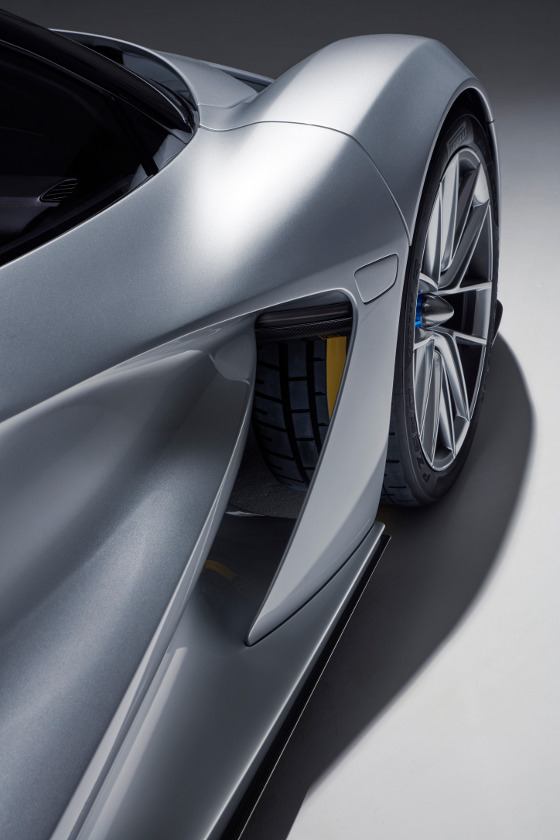
The Lotus Evija is also equipped with ESP stability control to ensure safety in all road conditions, with further grip provided by the four-wheel drive system. A pure steering feel is assured via an electro-hydraulic system.
The car's motorsport-derived suspension features three adaptive spool-valve dampers for each axle. Two are corner dampers, with a third to control heave. These are mounted in-board to optimize the aerodynamic performance. They are manufactured by Multimatic, specialists in developing high-performance suspension technology for on-road, off-road, and motorsport applications, including Formula 1.
Magnesium wheels provide optimum lightness and strength, and are sized 20 and 21 in. at the front and rear, respectively. They wear Pirelli Trofeo R tires, developed specifically to achieve ultimate performance. To deal with the Evija's extreme performance, the car is equipped with a forged aluminum AP Racing braking system with carbon ceramic discs front and rear.
The Evija also boasts the world's fastest-charging battery. The battery has the ability to accept an 800-kW charge, although charging units capable of delivering this are not yet commercially available (good pre-emptive thinking!). When they are, it will be possible to fully replenish the battery in just 9 min.
Using existing charging technology, such as a 350-kW unit (currently the most powerful available), the Evija's charge time will be 12 min. to 80 percent and 18 min. to 100 percent. The car's range is 250 miles (400 km) on the WLTP Combined Cycle, or 270 miles on the NEDC Combined Cycle. Lotus is in discussions with external suppliers on a charging solution for customers. The CCS2 charging socket is hidden behind a vented flap at the rear of the car.
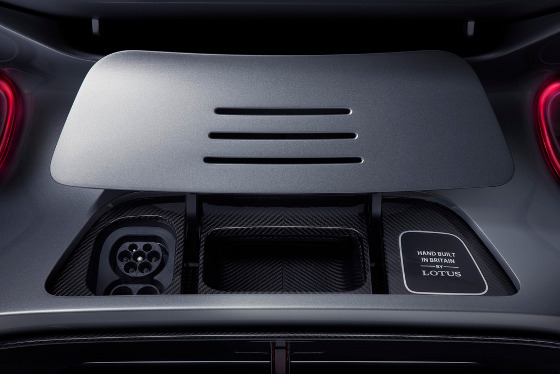
Inspired by the technical precision of race car engineering, the dominant characteristic of the cabin is the "floating wing" dashboard, which can be glimpsed from outside through the windscreen. The design also echoes the "porosity" of the exterior.
"The shape is inspired by the company's prototype racing cars of the late Fifties and early Sixties," said Carr. "It has a beauty and an elegance to it, and represents a typically Lotus approach because it performs multiple functions. It houses the instrument panel and air ducts, and is also an integral structural support. It reinforces [Lotus founder] Colin Chapman's cast-iron rule that no Lotus component goes along for a free ride."
Access to the cabin is through the two dihedral doors. Handle-free to preserve the sculpted exterior, they're operated via the key fob. It's the first time Lotus has used such doors.
Once in the car, a switch in the roof console closes the doors. The location aids the minimalist layout of the main control panel and prevents them being activated accidentally. This detail is a tribute to one of the most iconic Lotus cars. "Versions of the Lotus Esprit Turbo featured a huge roof console in the late Seventies and early Eighties. It's not something you might expect on a contemporary hypercar, but Lotus fans will love the connection," Carr said.
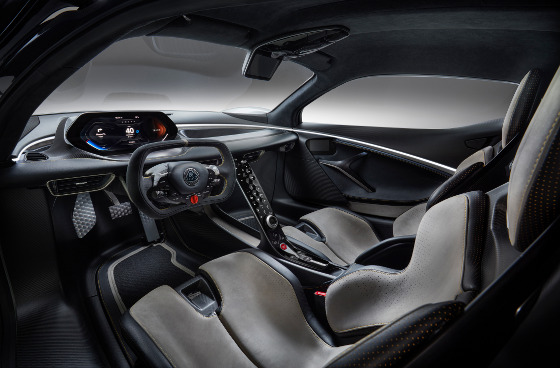
The elegant carbon fiber shell seats are hand trimmed with thick Alcantara-finished pads and feature manual fore/aft adjustment plus electric back operation. The steering column is manually adjustable for both rake and reach. Three-point seat belts are fitted as standard, with four-point harnesses an option. Built into the bodyshell, close to the occupants' hip point, are two bespoke storage areas.
The design of the steering wheel is similar to that found in a Le Mans Prototype or F1 car.
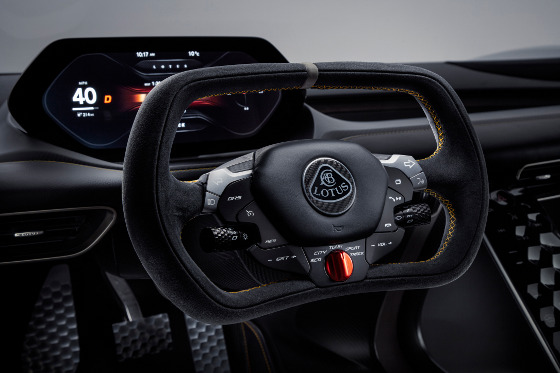
Mounted centrally at the base of the steering wheel's hub is the mode controller. Ahead of the steering wheel is a state-of-the-art digital display, providing the driver with key information such as mode, battery charge, and remaining range. It is the car's only screen, putting all necessary information in one place. The screen displays essential functions only, with information appearing as required when the appropriate button is pushed, then fading when no longer needed.
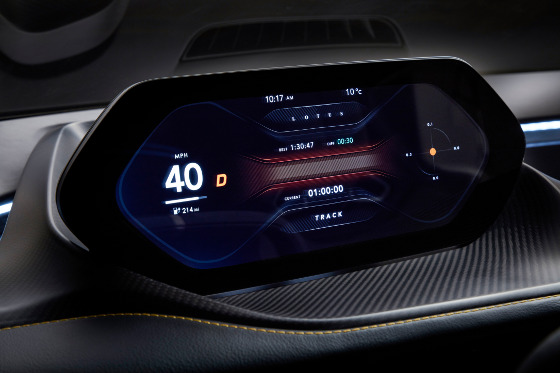
Further controls are located on the floating "ski slope-style" center console (we think this is pretty neat!), which features touch-sensitive haptic feedback buttons. Each is integrated in hexagonal recesses to help guide the driver's fingers. The driver can also interact intuitively with the car's technology via a control wheel. The honeycomb design of the buttons is replicated on indicator stalks and on the surface of the aluminum foot pedals.
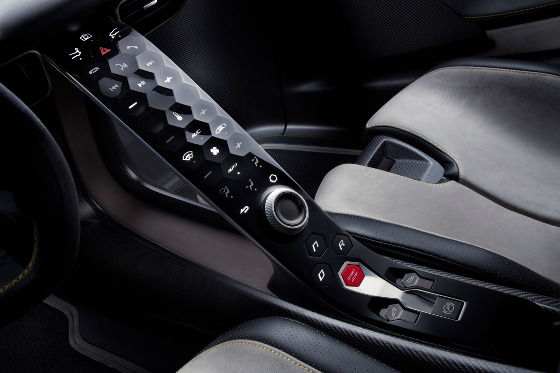
The Evija is the first Lotus to provide drivers with a full suite of digital connected infotainment, which will benefit from over-the-air software updates. A powerful on-board modem enables communication to the cloud, and the driver can interact with that data through a Lotus smartphone app. The app will enable drivers to monitor their Evija from anywhere in the world, for example, to check the battery charge status and driving range. It will also support remote use of air-con to heat or cool the cabin ahead of the next drive.
Lotus says it will offer Evija customers an unparalleled level of personalization -- enabling them to specify the car exactly as they wish. This will include selecting unique paint finishes, interior trims, and detailing.
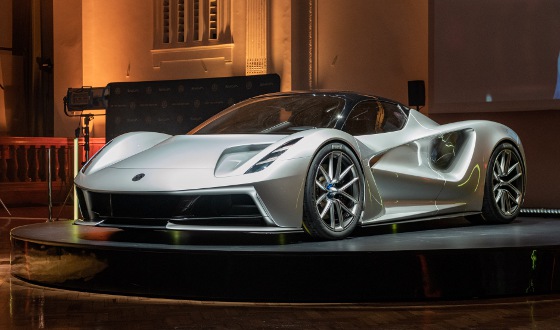
This car is limited to 130 units (cleverly, its Lotus project code is Type 130). Production will begin in 2020 and will take place in Hethel in the east of England, which has been the home of Lotus since 1966. The Evija is priced from £1.7m (Currently $2,052,000 USD) plus duties and taxes.
Source: Lotus Cars
Published August 2019
Rate this article
View our terms of use and privacy policy
